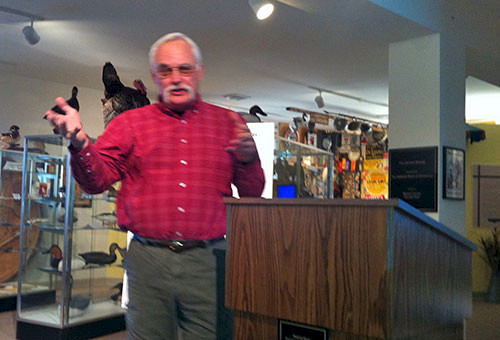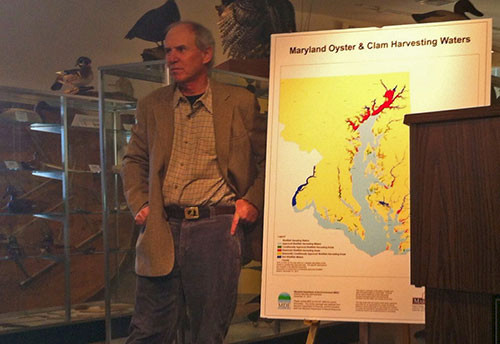Dorchester County citizens concerned about Chesapeake Bay
Bill Dennison ·I attended the 6th Annual Dorchester Citizens for Planned Growth meeting at the Dorchester County Historical Society on January 27. It was a good gathering of people who live on or near the streams, rivers and Chesapeake Bay of Dorchester County. Dorchester County has a lot of wetlands and streams, with abundant wildlife. The event featured local oysters on the half shell and goose meat. There were two skipjack captains in the audience as well. The meeting was chaired by Fred Pomeroy, President of the Dorchester Citizens for Planned Growth.

The first order of business was the Environmental Stewardship Award, which was given to C.A. Porter Hopkins, a former state member of the general assembly (1967-1975) and state senator (1975-1978). One of Porter's major accomplishments was to be one of the founding members of the Chesapeake Bay Foundation in the 1960s. He received a beautiful framed photograph by David Harp, Chesapeake Bay's premier nature photographer.
Dr. Roman Jesien presented five years of citizen monitoring data which showed elevated levels of total nitrogen (>1.0 mg/L) and total phosphorus (>0.1 mg/L) in the Transquaking, Chicamacomico, Little Blackwater Rivers and Cambridge Creek. There was some intriguing data from the Transquaking River, which has chronically high levels of Harmful Algal Blooms, with high levels of total phosphorus in the downstream reaches. Kathy Brohawn from the Maryland Department of the Environment showed some of the results from the shellfish contamination sampling and indicated the streams and rivers of Dorchester County which have been closed to shellfish harvesting. Some confounding data in the Little Choptank River provided another data anomaly, once again reinforcing the need for continued research to help direct Chesapeake Bay restoration.


I spoke about the impacts of Hurricane Sandy and used the satellite images following Tropical Storm Lee in 2011 and Hurricane Sandy in 2012 to demonstrate the lack of impact of Susquehanna River flow on the Choptank River water quality. Dorchester County recently joined several other counties in taking legal action against the Conowingo dam, and the satellite photos combined with the citizen monitoring data dispel the notion that the water quality issues of Dorchester County related to the Conowingo dam. I also showed the declining water quality in the Choptank River on the EcoCheck website which stimulated an active discussion of what steps need to be taken in Dorchester County to reverse this trend. It was a good group and I am always encouraged when I meet with citizens who focus on what can be done, rather than worrying about who is to blame.
About the author
Bill Dennison

Dr. Bill Dennison is a Professor of Marine Science and Vice President for Science Application at the University of Maryland Center for Environmental Science.
Next Post > "Raising the bar" vs. "Dumbing it down" for science communication
Comments
-
Miaohua 12 years ago
Good article! The article mentioned an interesting issue: Water Quality. What is the criteria for the Maryland State of the water quality? Is there some restriction on TP,TN,salinity, or other factor?
-
Catherine McCulley 12 years ago
Bill-
Thanks so much for speaking at our meeting. Your comments better informed the audience. Glad we do have so many people who are interested in improving the health of the bay!
Catherine (DCPG)

